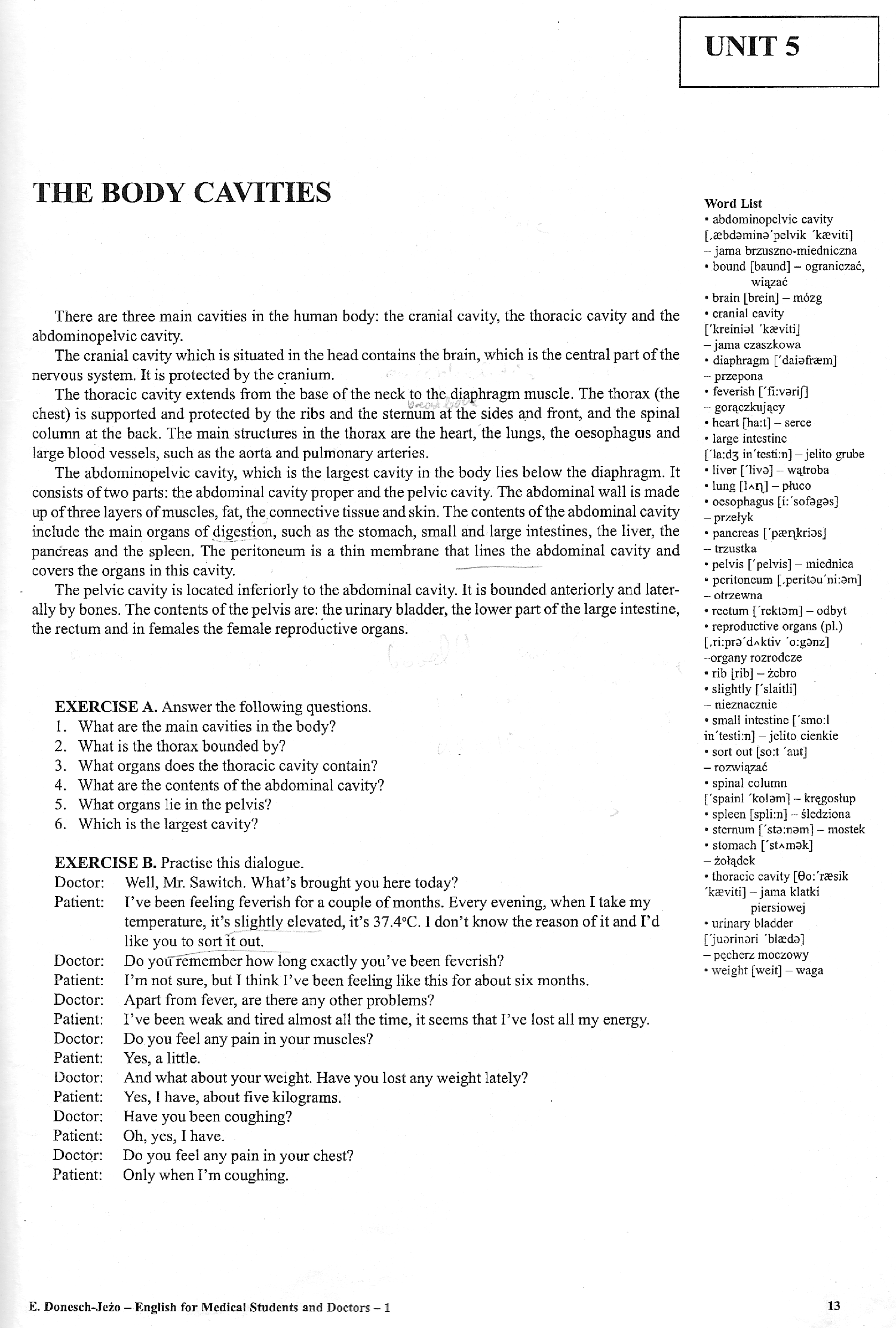13

THE BODY CAYITIES
There are three main cavities in the human body: the cranial cavity, the thoracic cavity and the abdominopelvic cavity.
The cranial cavity which is situated in the head contains the brain, which is the central part of the nervous system. It is protected by the cranium.
The thoracic cavity extends from the base of the neck to the diaphragm muscle. The thorax (the chest) is supported and protected by the ribs and the stemum at the sides and front, and the spinał column at the back. The main structures in the thorax are the heart, the lungs, the oesophagus and large blood vessels, such as the aorta and pulmonary arteries.
The abdominopelvic cavity, which is the largest cavity in the body lies below the diaphragm. It consists of two parts: the abdominal cavity proper and the pelvic cavity. The abdominal wali is madę up of three layers of muscles, fat, the.connective tissue and skin. The contents of the abdominal cavity include the main organs ofdigestion, such as the stornach, smali and large intestines, the liver, the pancreas and the spleen. The peritoneum is a thin membranę that lines the abdominal cavity and covers the organs in this cavity.
The pelvic cavity is located inferiorly to the abdominal cavity. It is bounded anteriorly and later-alły by bones. The contents of the pelvis are: the urinary bladder, the lower part of the large intestine, the rectum and in females the female reproductive organs.
EXERCISE A. Answer the following ąuestions.
1. What are the main cavities in the body?
2. What is the thorax bounded by?
3. What organs does the thoracic cavity contain?
4. What are the contents of the abdominal cavity?
5. What organs lie in the pelvis?
6. Which is the largest cavity?
EXERCISE B. Practise this dialogue.
Doctor: Weil, Mr. Sawitch. Whafs brought you here today?
Patient: T’ve been feeling feverish for a couple of months. Every evening, when I take my
temperaturę, it’s slightly elevated, it’s 37.4°C. 1 don’t know the reason of it and I’d like you to sortlt out.
Doctor: Do yoiTfemember how long exactly you’ve been fevcrish?
Patient: I’m not surę, but I think l’ve been feeling like this for about six months.
Doctor: Apart from fever, are there any other problems?
Patient: I’ve been weak and tired almost all the time, it seems that I’ve lost all my energy.
Doctor: Do you feel any pain in your muscles?
Patient: Yes, a little.
Doctor: And what about your weight. Have you lost any weight lately?
Patient: Yes, i have, about five kilograms.
Doctor: Have you been coughing?
Patient: Oh, yes, I have.
Doctor: Do you feel any pain in your chest?
Patient: Only when Pm coughing.
E. Donesch-Jeżo - English for Medical Students and Doctors - 1
Word List
• abdominopclvic cavity [,ffibdamina’pelvik 'kaeviti]
- jama brzuszno-miedniczna
• bound [baund] - ograniczać,
wiązać
• brain [brein] - mózg
• cranial cavity ['kreinial 'ka;vitij —jama czaszkowa
• diaphragm ['daiafraem]
- przepona
• feverish ['fi:varij]
- gorączkujący
• heart [ha:t] — serce
• large intestine
[ la:d3 in'tcsti:n] — jelito grube
• liver ['liva] - wątroba
• lung [Uą] - płuco
• oesophagus [i:'sofagas]
- przełyk
• pancreas ['pćeijkriosj
- trzustka
• pelvis ['pelvis] - miednica
• peritoneum [,peritau'ni:am]
- otrzewna
• rcctum [rektam] — odbyt
• reproductive organs (pl.) [,ri:pra'dAktiv 'o:ganz] -organy rozrodcze
• rib [rib] - żebro
• slightly ['slaitli]
- nieznacznie
• smali intestine ['smo:l in'testi:n] - jelito cienkie
• sort out [sod 'aut]
- rozwiązać
• spinał column
['spainl 'kolam] - kręgosłup
• spleen [spli:n] - śledziona
• stemum ['stamam] — mostek
• stornach ['stAmak]
- żołądek
• thoracic cavity [0o:'ra?sik 'kćeviti] - jama klatki
piersiowej
• urinary bladder
[ juorinari 'blada]
- pęcherz moczowy
• weight [weit] — waga
13
Wyszukiwarka
Podobne podstrony:
Revision Unit Test AThere is, there are *ł Uzupełnij zdania o rzeczach znajdujących się na stole,
There are three basie configurations of ultrafiltration membranes: fiat disc, hollow fiber and spira
IntroductionWhat are the New English File Level Tests? There are three Level Tests, which correspond
s typefuse1 Fuse box locations There are three separate fuse boxes fitted to the Yehicle, each one c
77410 WELCOME KIDS 2 ANGIELSKI ZESZYT ĆWICZEŃ 27 Look and write. 0 E mm E mOÓÓ 0 00 a Ther
Subscription warrants Basically, there are two main types of warrants, subscription warrants and der
Different tests There are three types of Covid-19 tests currently available. Each of them serves a d
room. e Yes, there is. It s in the drawer. f There are three hundred and twenty. 2** Napisz pytania
Reported speech angiekski 2 _____7 Reported Speech There are three types of Reported Speech: stateme
69122 skanuj0007 (353) U 6. Film crews don t want to rent houses outside London be
więcej podobnych podstron